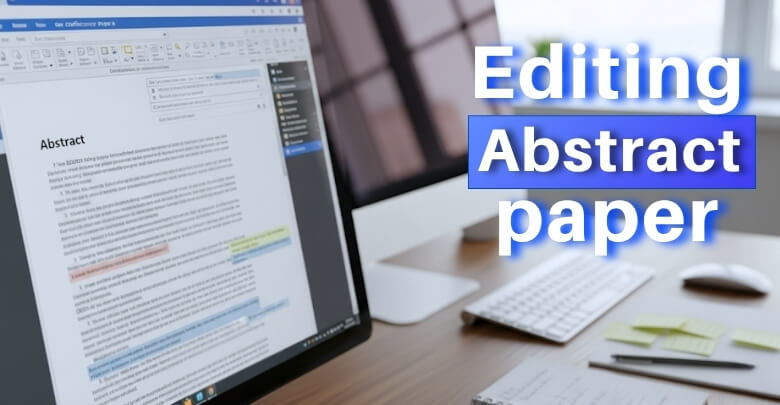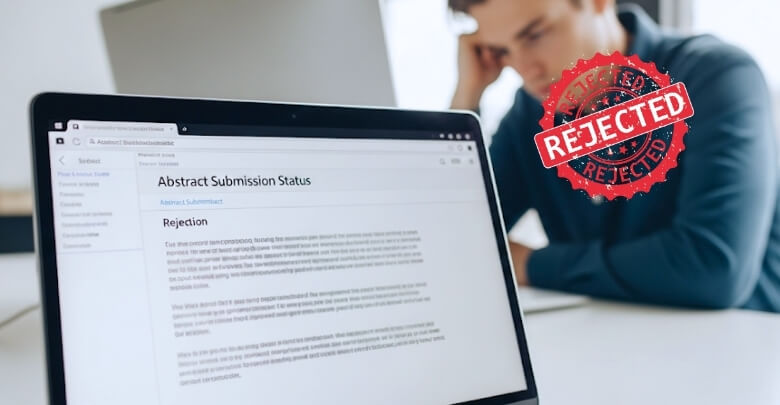A good abstract for a scientific paper or conference presentation can open doors and get your work noticed by many people. It acts like a short window into your research, letting others quickly see what your project is all about. Many people want to make their abstract stand out, and they often wonder, how to write a good abstract for a scientific paper or conference presentation?
To write a good abstract for a scientific paper or conference presentation, follow the event’s rules and format. Choose a short, clear title. Explain why your topic matters, what problem you’re solving, how you did it, and what you found. Match the event’s theme, use simple words, stay clear, and check for mistakes before submitting.
Do you want to know the step-by-step process for making your abstract the best it can be? Then read on, because this article has all the important details you need to learn about the topic.
How to Write a Good Abstract for a Scientific Paper or Conference Presentation?
Writing a good abstract for a scientific paper or conference presentation isn’t as hard as it may seem. You just need to follow some simple steps to make your work stand out. It’s all about being clear, organized, and easy to understand. If you’re ready to learn, keep reading below!
Follow the Rules
Before you start writing, check the rules given by the conference. There might be a word limit, a way to format your text, or certain things they want you to include. If you miss any of these, your abstract might not be accepted. Look for details like how to list authors or what keywords to add. Doing it right from the start saves time later.
Catchy and Clear Title
Choose a title that says what your paper is about in a short and simple way. Try to keep it under 12 words. Make it sound interesting, but don’t make it too fancy or confusing. A good title helps people quickly understand your topic. It’s like a short label for your work.
Easy Abstract Structure
Your abstract should follow a simple flow. Start by saying why your topic matters. Then share what problem or question you’re trying to solve. After that, give a short idea of how you worked on it. Finish by saying what you found or hope to find and why it’s important.
Match the Theme
Make sure your abstract matches what the conference is mainly about. Each event has a main topic, and your work should fit into it. Try to understand what the event is looking for and write your abstract to match that. For example, conferences in USA often focus on science, health, or new ideas, so it helps if your topic fits one of those. This way, your abstract is more likely to get noticed.
Keep It Simple
Use simple words and short sentences. Don’t try to sound too smart or use big words that are hard to understand. People from different fields should be able to read your abstract and get the idea. The clearer you are, the better your abstract will be. It’s okay to sound natural and to the point.
Be Specific
Avoid saying things like “this is very important” without saying why. Instead, explain what you found and what it means in a simple way. Saying something clearly and directly makes it stronger. Don’t leave readers guessing. Let them see the real point of your work.
Edit and Improve
After writing, take a break, then read it again. You might see mistakes or parts that don’t sound right. Ask someone else to read it too—they might notice things you missed. Fix anything that’s unclear or boring. Good editing makes a big difference.
Last-Minute Checks
Before sending your abstract, read the rules again. Make sure you followed everything like word count, format, and spelling. Check your grammar and that all the needed parts are there. Submit it before the deadline, not at the last minute. A careful final look can help avoid silly mistakes.
Key Components of an Effective Scientific Abstract
A strong abstract is built with clear and essential parts. Each part plays a role in helping the reader quickly understand your research. Here’s a simple guide to what you should include and why it matters.
| Component | What to Include | Why It Matters |
| Background | A short intro to the topic and why it’s important. | Helps readers understand the context of your work. |
| Objective | The main goal or question your research is trying to answer. | Shows what your study is focused on. |
| Methods | A quick look at how you did your research or study. | Tells readers how the results were achieved. |
| Results | A brief summary of what you found or what you expect to find. | Gives a clear idea of the outcome or expected outcome. |
| Conclusion | The meaning of your findings and what they might lead to. | Explains why your work matters and what it could change or improve. |
| Relevance to Conference | Relevance of topics to the theme or subject of the event. | Helps your abstract fit well into the conference focus. |
These points make your abstract complete and easy to follow. When you include each part, you help readers quickly learn what your research is about. Always remember, a good abstract gives a full picture in just a few words.
Should You Write the Abstract First or Last?
Many people often wonder when the best time is to write an abstract while working on a research paper or presentation. Some try writing it first to guide their thoughts, while others leave it for the end. Both methods work, but it depends on how clear your ideas are from the beginning.
If your plan is clear and you know what you will write, starting with the abstract can help you stay focused and organized. It gives a quick outline of your topic, goals, and key points, keeping your work on track. But remember, things might change while writing the full paper, so you may need to update it later.
On the other hand, writing the abstract last helps you include only what’s actually in your paper, not just what you planned. This way, the summary fits perfectly with your final work, making it more accurate and clear. No matter when you write it, make sure your abstract is simple, short, and easy to understand.
When to Use Citations in a Scientific Abstract?
When writing a scientific abstract, there are some simple rules you can follow to make it strong and clear. One thing many people wonder about is using citations. Should you add them or not? To understand this better, let’s look at a few key points below.
Rarely Needed
Most of the time, you don’t need to use citations in an abstract. Abstracts are meant to give a quick summary of your work, not list other people’s ideas. If you fill it with references, it can feel too heavy and unclear. It’s better to keep the focus on your own study. Let the full paper handle the detailed sources.
Use Only If Required
Sometimes, the conference or journal will ask for citations in the abstract. If they do, then you should add them. Always check the rules before you start writing. If nothing is said, it’s safer to leave citations out. Doing only what’s asked keeps things simple and clear.
Mention Known Facts
If you’re sharing something that most people in your field already know, you don’t need to cite it. Basic facts don’t need a source. For example, if you say water boils at 100°C, everyone accepts that. Save citations for uncommon or surprising claims. This keeps your abstract short and smooth.
Citing Other Work
Only add a citation if your study directly builds on another person’s work. Even then, just naming the researcher is usually enough. You don’t need full details like you do in the main paper. Just saying “based on the method by Smith” is often enough. Don’t crowd the abstract with too much detail.
Focus on Your Work
Your abstract is mainly about your own study, so give it the spotlight. Use the space to explain your ideas, your methods, and your results. Other people’s work can be saved for later in the full paper. Stay focused on what you’ve done. That’s what readers want to know first.
Keep It Simple
If you’re unsure, it’s best to skip citations in your abstract. They’re usually not needed and can make the writing harder to read. A clean and easy-to-read abstract is better than one filled with extra names and numbers. Keep your words simple and clear. That’s what makes a good abstract strong.
Does Formatting Influence the Acceptance of Your Abstract?
Yes, formatting does influence the acceptance of your abstract in many cases. Reviewers often look at how neat and clear it looks. A well-formatted abstract shows that you’ve followed the rules and paid attention to details. Even small mistakes can give the wrong impression and hurt your chances quickly.
Every conference gives specific rules for things like word count, spacing, and headings. You should also be careful with the font use in conference paper because it matters more than people think. Using the wrong style or size can make your abstract harder to read. Always double-check what the event asks for before submitting your work.
Clean layout makes your writing easier to follow and more professional. Simple things like margins, spacing, and bold titles make a big difference. It shows respect for the guidelines and helps your abstract stand out in the right way. So yes, formatting really can help get your abstract accepted.
How to Edit Your Abstract Like a Professional?
Once you finish writing your abstract, the next step is to make it better by editing it the right way. Editing helps clean up mistakes and make everything clearer. If you want your abstract to sound strong and neat, keep reading below.
Take a Short Break
After writing, take a short break before editing. A fresh mind helps you spot mistakes more easily. Even 15 minutes can make a big difference. When you come back, read slowly and carefully. This makes it easier to catch things you didn’t notice before.
Read It Aloud
Reading your abstract out loud helps you hear how it sounds. You’ll notice if a sentence is too long or confusing. If something sounds odd, it probably needs fixing. This simple trick makes your writing clearer. It also helps with finding small grammar mistakes.
Cut Extra Words
Sometimes we add too many words without meaning to. Try cutting out words that don’t add anything important. Short and simple sentences are easier to read. Make sure each word has a clear purpose. The goal is to keep your abstract clean and strong.
Fix Grammar Mistakes
Check your spelling, punctuation, and grammar carefully. A small mistake can make your work look less serious. Use tools or ask someone to help if you’re unsure. Make sure every sentence is correct. This step helps your abstract look neat and professional.
Check the Order
Make sure your ideas are in the right order. Your abstract should start with the topic, then the problem, method, and result. Each part should flow into the next. If something feels out of place, move it around. A good order makes it easy to follow.
Ask for Feedback
After editing on your own, share your abstract with someone you trust. They might find things you didn’t see. Ask if it’s clear and easy to understand. A second opinion can really help. It’s always good to have another set of eyes.
Read the Rules Again
Before you finish, check the rules given by the event. Make sure your abstract fits the format, length, and style they asked for. Double-check things like font, spacing, and headings. These small details matter. Following the rules makes your work look ready and complete.
How to Get Feedback on Your Abstract Before Submission?
Before sending in your abstract, it’s a good idea to check if it makes sense and clearly shares your main ideas. Sometimes, what sounds fine to you might confuse someone else. Below are some simple ways to get helpful feedback:
Ask a Mentor
Mentors can be very helpful because they know what makes a strong abstract. They can guide you on how to write a good abstract for a conference paper by pointing out unclear parts or missing details. Just ask them to read your draft and tell you what they think. You don’t need to worry about making it perfect first. Their advice can really improve your writing.
Talk to Colleagues
Sharing your abstract with someone else can give you a fresh view. A friend or teammate might notice small mistakes you missed. They can also tell you if your ideas are easy to understand. Even one extra set of eyes can help a lot. Feedback from someone you trust is always useful.
Use Peer-Review Tools
There are some simple tools online where people help each other improve their work. You can upload your abstract and get reviews from others. They often give clear tips on what to change or fix. It’s a quick way to see how others understand your writing. Just make sure you use trusted platforms.
Read It Aloud
Reading your abstract out loud helps you catch mistakes or sentences that sound confusing. It’s easier to hear what doesn’t flow well. You might even find better ways to say something just by listening. This works best when you take a short break before reading. Give your brain a little rest first.
Print and Review
Sometimes, looking at your work on paper feels different than reading it on a screen. You might notice grammar or spacing mistakes more easily. It also helps you focus better without getting distracted. Take a pen and mark anything that seems off. It’s a simple but powerful trick.
Try Group Review
If you have a group working on research, ask them to review each other’s abstracts. Everyone brings a different idea to the table. You can learn from their feedback and also help improve theirs. Make it a fun and useful habit. It also builds teamwork skills.
Give It Time
Don’t rush your final version. After getting feedback, take time to fix your abstract carefully. Let it rest for a day and check it again. You’ll see it more clearly with fresh eyes. Good feedback works best when you give it time to sink in.
What Happens After You Submit Your Abstract?
Once you hit submit, it may feel like your work is done—but that’s only the beginning of what happens next. There are a few steps your abstract goes through before you hear anything back. Want to know what really happens after submission? Keep reading to find out.
Goes to Reviewers
After you submit your abstract, it gets sent to people who review it carefully. These reviewers are usually experts in the topic. They check if your work is clear, correct, and fits the event’s theme. They don’t just look at the writing—they also look at the ideas. Their job is to choose the best abstracts.
Scored and Rated
The reviewers give each abstract a score based on set rules. They look at things like how well it’s written and how interesting the topic is. Sometimes they also check if the research is new or useful. The higher your score, the better your chances. Every abstract is rated fairly.
Wait for Results
Once the review is done, you have to wait for the results. This part can take days or even weeks. It depends on how many abstracts were sent in. During this time, just be patient. Don’t worry if you don’t hear back right away.
Get the Decision
You will get an email or message that tells you if your abstract was accepted or not. If it’s accepted, the message will also give you the next steps. If not, don’t feel bad—many people try again and do better next time. Either way, you’ll know the result clearly. Make sure to read the message carefully.
Prepare Your Work
If your abstract is accepted, it’s time to prepare your full paper or presentation. You’ll need to follow the event’s rules again. There may be a deadline, so plan your time well. This part is where you share your full ideas. Get ready to show your best work.
Accepted for Presentation
When accepted, your abstract may be turned into a talk or a poster for the event. You’ll be given a time slot or space. Practice your talk or make your poster clear and nice to look at. This is your chance to share your work with others. It’s a big step forward.
Published in Program
Your abstract may be published in the event’s program or online book in some cases. This means more people can read your work. It also helps others learn from what you did. Make sure your abstract is final and correct. Once published, it stays the same.
Things to Do if Your Abstract Is Rejected
Getting a rejection can feel a bit upsetting, especially after working hard on your abstract. But don’t worry—it happens to many people. What matters is what you do next. Here are some things to do if your abstract is rejected:
Stay Calm First
It’s normal to feel upset, but don’t let it get you down for too long. Rejections happen to everyone, even experienced writers. Take a deep breath and give yourself a short break. It’s okay to feel sad, but don’t stop trying. You still have many chances ahead.
Read the Feedback
If you got feedback on the rejection, read it carefully. Reviewers may point out what needs to be better. This can help you know where your abstract went wrong. Use those comments to improve your work. Good feedback is like a guide for your next step.
Review Your Work
Go back to your abstract and read it again with fresh eyes. Try to spot what could be clearer or stronger. Fix any weak points or parts that may confuse readers. Make your ideas simple and easy to follow. Even small changes can make a big difference.
Ask for Help
Show your abstract to someone you trust and ask what they think. A second opinion can help you see things you missed. They might give ideas on how to explain something better. Don’t be shy about asking for advice. It can make your work stronger.
Try Another Event
If your abstract wasn’t right for one event, it might be perfect for another. Look for other conferences or places that match your topic. You may only need to adjust a few lines. Keep sending your work out there. You never know who will say yes next time.
Don’t Give Up
One rejection does not mean your work isn’t good. Many people face rejection before they succeed. What matters is that you keep improving and keep going. Learn from the experience and try again. Your next chance could be right around the corner.
Frequently Asked Questions
Even after you’ve learned the fundamentals of abstract writing, you may still have a few questions. These FAQs cover extra tips, common mistakes, and other useful points that haven’t been discussed yet. Check out the questions below to get even more helpful insights.
How Can I Make My Abstract Stand Out?
To stand out, make sure your abstract is clear, well-written, and closely matches the event’s topic. Avoid extra words and stay focused on the main idea. Use strong, active sentences that tell exactly what your research is about. A well-structured and honest abstract always does better.
How Long Should a Scientific Abstract Be?
Most scientific abstracts are between 150 to 500 words, depending on the conference or paper rules. It’s important not to go over the word limit, but also not to leave out key points. Focus on keeping it short but complete. Follow the word count rules carefully every time.
Can Humor Be Used in a Scientific Abstract?
It’s best not to use humor in a scientific abstract. Abstracts should sound serious, clear, and professional. Humor can confuse readers or make your work seem less important. Stick to facts and keep the tone respectful and focused on the research.
Is It Okay to Use Quotes in an Abstract?
Using quotes in an abstract is not common and usually not recommended. Abstracts are meant to summarize your own work, not highlight someone else’s words. Quotes can take up space and distract from your main points. Keep the focus on your study and findings.
How Do I Know If My Abstract Is Too Vague?
If your abstract sounds general and doesn’t clearly explain your topic, it’s likely too vague. Make sure you say what your study is about, what you did, and what you found. Use specific words instead of unclear ones like “important” or “interesting.” Add real details that show the value of your work.
How Many Revisions Should I Do Before Submitting the Abstract?
It’s good to revise your abstract at least three times. Start with fixing big problems, then work on grammar and sentence flow. Take breaks between edits to see mistakes clearly. More careful edits make a stronger final version.
Can I Reuse Part of My Abstract in the Main Paper?
Yes, you can reuse some sentences in your full paper, especially if they explain your research well. Just make sure it fits the tone and structure of your full text. Don’t copy the abstract into every section—use it as a base and expand.
What If My Abstract Topic Changes Later?
If your topic or findings change after submission, update your abstract as soon as possible—if the deadline hasn’t passed. Some events allow small edits before final approval. If not, you may have to submit a new version or wait for the next event.
Bottom Line
Making your abstract stand out is all about sharing your ideas in a clear and simple way. Remember, the abstract is often the first thing people see, so make those words count. When you focus on the basics and avoid extra fluff, your work is easier to understand and more likely to be noticed.
Keep improving each draft by checking the rules, staying on topic, and cutting out anything that doesn’t help your message. Always read your work again and listen to helpful advice from others. Each step brings you closer to an abstract that really works.
If you follow these steps for how to write a good abstract for a scientific paper or conference presentation, you’ll feel more confident and ready for success. Let your research speak for itself, and enjoy the process of sharing your ideas.









